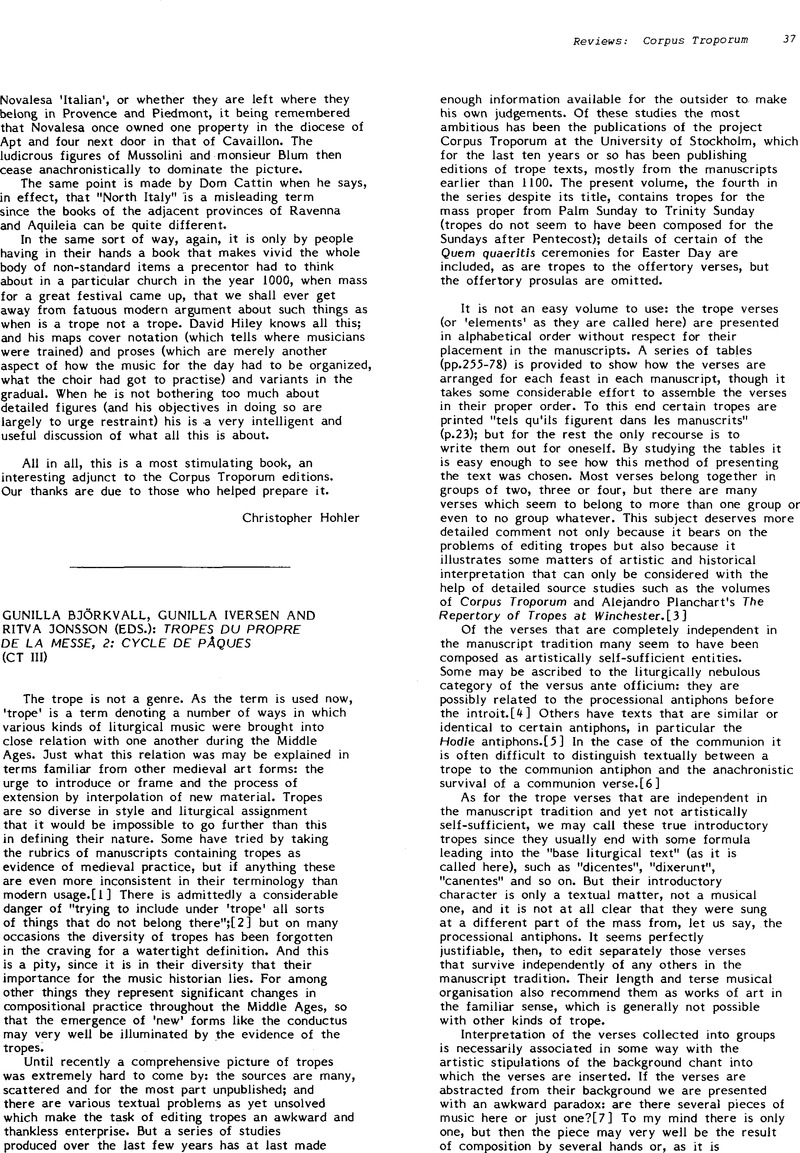No CrossRef data available.
Published online by Cambridge University Press: 14 July 2009

[1] On the evidence of the rubrics see Odelman, E.: ‘Comment a-t-on appelé les tropes? Observations sur les rubriques des tropes des Xe et XIe siècles’, Cahiers de civilisation médiévale 18 (1975), pp. 15–36 CrossRefGoogle Scholar.
[2] Crocker, R.L.: ‘The troping hypothesis’, Musical Quarterly 52 (1966), p.184 Google Scholar.
[3] Planchart, A.E.: The Repertory of Tropes at Winchester (2 vols., Princeton, 1977)Google Scholar.
[4] Planchart, op.cit., vol.1, p.235. An example of such a versus in the present volume is Quem creditis (p.173).
[5] As for instance Populus acquisitionis (p.161), which is described as an antiphon in the manuscript Vienna, Nationalbibliothek, Cod.lat.701, f.32v; cf. Andrieu, M. (ed.): Les Ordines Romani du haut moyen âge, Spicilegium sacrum Lovaniense: études et documents, 29 (Louvain, 1961), p.305 Google Scholar, line 29. The example is important because the position of the antiphon before the introit for Easter Day is directly comparable to that of a trope.
[6] These are listed in the commentary to the first of them, Adducite vitulum (p.226).
[7] This question is discussed further in Crocker, R.L.: ‘Some remarks on the shape of music’, Current Musicoiogy 5 (1967), pp.50–56 Google Scholar.
[8] Planchart, op.cit. (note 3), vol.2, pp. 150–1.
[9] In the manuscript Paris, Bibliothèque Nationale, lat.1118 this verse is part of a series beginning Immortalis filius dei.
[10] The term from Rönnau, K.: Die Tropen zum Gloria in excelsis Deo (Wiesbaden, 1967), p.85 Google Scholar.
[11] All three melodies are transcribed in parallel in Sevestre, N.: ‘The Aquitanian tropes of the Easter introit – a musical analysis’, this Journal 3 (1980), pp.35–6Google Scholar.
[12] Stäblein, B.: ‘Zum Verständnis des “klassischen” Tropus’, Acta musicologica 25 (1963), pp.84–95, esp. 94–5Google Scholar; Evans, P.: The Early Trope Repertory of Saint Martial de Limoges, Princeton Studies in Music 2 (Princeton, 1970), pp.107–18Google Scholar;. N. Sevestre, op.cit. (note 11), pp.29–31.
[13] As they already have in Weiss, G. (ed.): Introitus-Tropen I: Das Repertoire der südfranzösischen Tropare des 10. und 11. Jahrhunderts, Monumenta Monodica Medii Aevi, 3 (Kassel, 1970)Google Scholar; and Sevestre, N.: Les tropes d'introit de Noël et de Pâques à l'origine du drame liturgique: étude du répertoire aquitain des Xe et XIe siècles (Dissertation, Doctorat du troisième cycle, University of Paris X – Nanterre, 1976)Google Scholar.
[14] Cf. Roederer, C.: ‘Can we identify an Aquitanian chant style?’, Journal of the American Musicological Society 27 (1974), pp.75–99 CrossRefGoogle Scholar, which considers some processional antiphons from the region.
[15] For a different view of the music in this manuscript see Treitler, L.: ‘Observations on the transmission of some Aquitanian tropes’, Forum Musicologicum 3 (1982), pp.11–58 Google Scholar.
[16] Lipphardt, W.: Lateinische Osterfeiern und Osterspiele, Ausgaben deutscher Literatur des XV. bis XVIII. Jahrhunderts, Reihe Drama 5 (5 vols., Berlin, 1976–6)Google Scholar; the sixth volume has not yet been published.
[17] Evans, op.cit. (note 12), has less than eleven pages on ‘The Historical Position of the Trope’ (pp. 17–27).